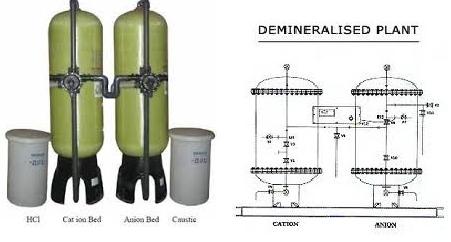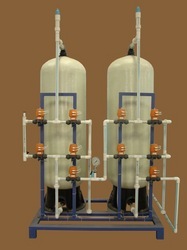DM Plant is an Ion exchange technology used to remove salts (cations and anions) from water. Soluble chemical compounds, when dissolved in water, become ionized; that is their molecules dissociate into positively and negatively charged components called ions.
Demineralization is the process of removing mineral salts from water by using the ion exchange process.
Demineralised water is water completely free (or almost) of dissolved minerals as a result of one of the following processes :
• Distillation
• Deionization
• Membrane filtration (reverse osmosis or nanofiltration)
• Electrodyalisis
• Or other technologies.
Demineralized water also known as Deionized water, water that has had its mineral ions removed. Mineral ions such as cations of sodium, calcium, iron, copper, etc and anions such as chloride, sulphate, nitrate, etc are common ions present in water. Deionization is a physical process which uses specially-manufactured ion exchange resins which provides ion exchange site for the replacement of the mineral salts in water with water forming H+ and OH- ions. Because the majority of water impurities are dissolved salts, deionization produces a high purity water that is generally similar to distilled water, and this process is quick and without scale buildup.
De-mineralization technology is the proven process for treatment of water. A DM Water System produces mineral free water by operating on the principles of ion exchange, Degasification, and polishing. Demineralized Water System finds wide application in the field of steam, power, process, and cooling.
| Principle : | |||||||||||
| Raw water is passed via two small polystyrene bead filled (ion exchange resins) beds. While the cations get exchanged with hydrogen ions in first bed, the anions are exchanged with hydroxyl ions, in the second one. | |||||||||||
| Process : | |||||||||||
| In the context of water purification, ion-exchange is a rapid and reversible process in which impurity ions present in the water are replaced by ions released by an ion-exchange resin. The impurity ions are taken up by the resin, which must be periodically regenerated to restore it to the original ionic form. (An ion is an atom or group of atoms with an electric charge. Positively-charged ions are called cations and are usually metals; negatively-charged ions are called anions and are usually non-metals). | |||||||||||
| The following ions are widely found in raw waters : | |||||||||||
|
|||||||||||
| Ion Exchange Resins : | |
| There are two basic types of resin – cation-exchange and anion-exchange resins. Cation exchange resins will release Hydrogen (H+) ions or other positively charged ions in exchange for impurity cations present in the water. Anion exchange resins will release hydroxyl (OH-) ions or other negatively charged ions in exchange for impurity anions present in the water. | |
| The application of ion-exchange to water treatment and purification. There are three ways in which ion-exchange technology can be used in water treatment and purification : | |
| first, cation-exchange resins alone can be employed to soften water by base exchange; secondly, anion-exchange resins alone can be used for organic scavenging or nitrate removal; and thirdly, combinations of cation-exchange and anion-exchange resins can be used to remove virtually all the ionic impurities present in the feedwater, a process known as deionization. Water deionizers purification process results in water of exceptionally high quality |






